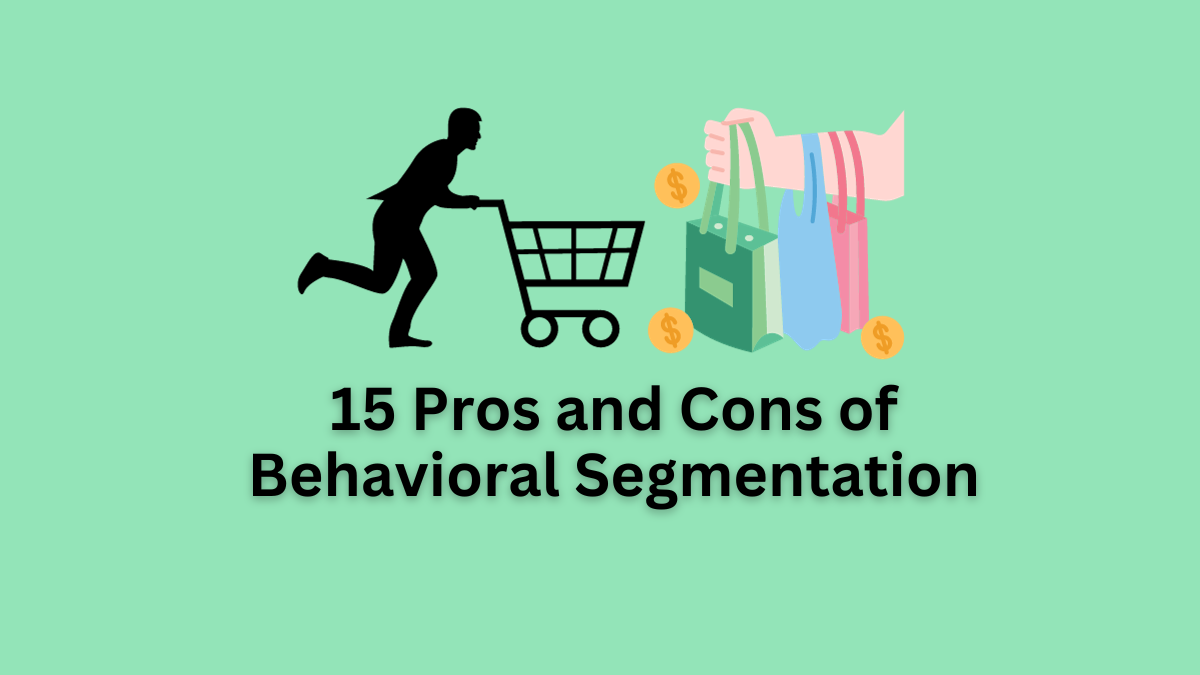Pros and Cons of Behavioral Segmentation
In this article, we will explore the key advantages and disadvantages or the pros and cons of behavioral segmentation to businesses. So, let’s explore them.
Pros of Behavioral Segmentation
Behavioral segmentation is a valuable marketing strategy that offers various benefits to businesses. Here are the eight advantages of behavioral segmentation to mention:
Personalized Marketing
Behavioral segmentation enables personalized marketing efforts. By understanding how different customer groups behave, companies can tailor their messages and offerings to match individual preferences. For instance, an e-commerce platform can recommend products based on a customer’s past browsing and purchase history, increasing the likelihood of a sale.
Improved Customer Engagement
Engaging customers effectively is a challenge, but behavioral segmentation simplifies this task. Companies can send targeted messages and offers to specific customer segments. For example, a clothing retailer can send promotions for winter coats to customers who have previously purchased winter apparel, enhancing engagement and conversion rates.
Read More: 8 Pros and 7 Cons of Psychographic Segmentation
Increased Customer Loyalty
Behavioral segmentation helps foster customer loyalty. Companies can identify loyal customers and reward them with exclusive offers, discounts, or loyalty programs. Loyal customers feel valued and are more likely to continue purchasing from the same company, leading to higher customer retention rates.
Efficient Resource Allocation
Resource allocation becomes more efficient with behavioral segmentation. Companies can focus their resources – time, budget, and personnel – on the most promising customer segments. For instance, a software company can allocate its sales team to focus on customers who have shown a strong interest in their product, improving the chances of conversion.
Targeted Product Development
Understanding customer behavior helps in product development. Companies can identify trends and preferences within customer segments, allowing them to create products that cater to specific needs. Smartphone manufacturers, for example, can develop features based on the behavior of different customer segments, such as gamers or photography enthusiasts.
Read More: 15 Examples of Psychographic Segmentation
Better Customer Satisfaction
Behavioral segmentation enables companies to anticipate customer needs and provide more satisfying experiences. By aligning products and services with behavior patterns, companies can exceed customer expectations. A restaurant can offer menu items and promotions based on the dining habits of its regular customers, enhancing overall satisfaction.
Enhanced Cross-Selling and Upselling
Companies can cross-sell and upsell more effectively through behavioral segmentation. By analyzing past behaviors, businesses can recommend complementary products or services. An online bookstore can suggest related books or accessories based on a customer’s previous purchases, increasing the average transaction value.
Informed Marketing Strategies
Behavioral segmentation informs marketing strategies with valuable insights. Companies can use data on customer behavior to refine their marketing approaches and messaging. For instance, an airline can adjust its advertising timing and content based on when customers typically search for flights, maximizing marketing effectiveness.
Read More: Psychographic Segmentation – Definition
Cons of Behavioral Segmentation
While behavioral segmentation offers various benefits – however, like any segmentation method, it also has its drawbacks. Here are seven key disadvantages or cons of behavioral segmentation:
Changing Customer Behavior
One of the primary cons of behavioral segmentation is the ever-changing nature of customer behavior. People’s preferences, habits, and buying patterns can evolve rapidly. For instance, during a pandemic, consumer behavior may shift dramatically. What was once a reliable behavior may no longer hold true. This means companies must continually update their segmentation models to stay relevant.
Read More: 4 Types of Market Segmentation
Data Privacy Concerns
Behavioral segmentation relies on collecting and analyzing customer data, which can raise privacy concerns. Customers may feel uncomfortable knowing that their behaviors are being tracked and analyzed. To address this, companies must be transparent about their data collection practices and ensure they comply with data protection regulations, such as GDPR or CCPA. Mishandling data can result in customer mistrust and legal repercussions.
Complex Data Analysis
Another drawback is the complexity of analyzing behavioral data. Understanding customer behavior requires advanced data analytics and the expertise to interpret the results accurately. Small businesses, in particular, may struggle with the costs and resources needed to carry out in-depth behavioral analysis, limiting their ability to benefit from this segmentation method.
Inaccurate Assumptions
Behavioral segmentation often relies on making assumptions based on observed behavior. However, these assumptions may not always be accurate. For instance, if a customer frequently buys organic food, it doesn’t necessarily mean they’re an environmentally conscious consumer. They might simply prefer the taste. Relying solely on behavioral data can lead to incorrect targeting.
Read More: 15 Examples of Demographic Segmentation
Limited Scope
Behavioral segmentation focuses solely on behavior, which can result in a limited understanding of customers. It doesn’t take into account other important factors such as demographics, psychographics, or cultural backgrounds. For example, two customers with similar buying behaviors may have different motivations and values that are not captured by behavioral segmentation alone.
Overlooking Individual Needs
A significant disadvantage is the risk of overlooking individual customer needs. Behavioral segmentation lumps customers into groups based on shared behavior, potentially neglecting unique preferences. For instance, two customers who both frequently purchase athletic shoes may have different athletic interests – one for running and the other for basketball. Neglecting these differences can lead to missed opportunities for personalization.
Short-Term Focus
Behavioral segmentation often emphasizes short-term behavior patterns, such as recent purchases or browsing history. While this can be useful for immediate marketing strategies, it may overlook the long-term customer relationship. Companies may become too focused on chasing quick sales and discounts without considering the lifetime value of a customer. This short-term approach can hinder long-term growth and customer loyalty.
Read More: 8 Pros and 7 Cons of Demographic Segmentation
Arti Kushmi holds a BBS (Bachelor in Business Studies) degree and shares her business and marketing knowledge through this website. While not writing she will be reading and enjoying the moment.
